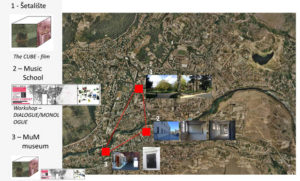Timespan: 13/11/2013 – 30/01/2015
Donor: Swedish Postcode Lottery and its Postcode Lottery Culture Foundation
Applicant: Färgfabriken (Stockholm / Sweden)
Partner: Local Democracy Agency Mostar (LDA Mostar)
Description: The project focuses on two cities that have historically been influenced by the richness of cultures and the fragmentation of society. Read more about NUT- New Urban Topologies on https://fargfabriken.se/en/previous-cities/mostar-bosnia-and-hercegovina.
Objectives: By empowering cultural institutions and individuals to take an active and strategic role in the field of urbanism, “New Urban Topologies” will promote sustainable and democratic urban development in Mostar and Beirut. This project will allow much needed cross-border dialogue within cities and between different social sectors.

Activities: The experiences of the project “New Urban Topologies – Mostar and Beirut” will be presented at an exhibition in autumn 2014 in both cities, with special reference to the process of urbanization and urban solutions that enable integration. The joint exhibition in Fargfabriken in the fall of 2014 will highlight and highlight ideas and experiences from Beirut and Mostar and other cities whose experiences are also actively involved in the project.
Exhibition – Autumn 2014
“Everywhere there is something to overcome or to bridge: disorder, death, meaninglessness. Everything is a transition, a bridge whose ends are lost in infinity, beside which all the Bridges of this earth are only children’s toys, pale symbols. And all our hopes lie on the other side.”
Nobel Prize winner for Literature – Ivo Andric

The city is made up of a mosaic of images of time that are woven into his being materially and spiritually. Know how to recognize and read the city in its time and architectural value is a kind of art. Reading Mostar would be of this kind.
Unfortunately, after the war of the nineties Mostar became a “case city” that was for a long period spoken only in a negative context, the city of parallelism, divisions and negative political and social events.
Yet the historical identity of the city of Mostar in its continuity is talking about the city of light, beauty and positive energy. However, it needs to be recognized and interpreted in a contemporary context. It is not easy to make stable steps in contemporary and future in the city in a city where everything is divided in half.
Although it is not easy it’s not impossible.
Today, twenty years after the war, after a series of successful physical reconstruction in the area, it is important to reconstruct and rebuild the relationship between citizens. It is a process that requires a lot of hard work, creativity and good will on either side.
One of the ways to establish dialogue and communication between different stakeholders is through an art. If one wants to understand what the future has to bring than he or she needs to acknowledge the past, and also must live in the present.
Also, in order to recognize yourself you must be seen through the situation and the fate of other people with the same or similar fate.
Exhibition Beirut_Mostar just aims to show people and cities and their towns that have similar fate. In order to vividly demonstrated this phenomenon as the main part of the exhibition it is planned to interpret the documentary, which will tell stories about cities and their people, the history, present, future, emotions, identity, social turmoil, etc.
The films will be used as a valuable medium to display rapid urban transformations, socially, politically, and architecturally. The city’s urban histories can be investigated and current urban transformations analyzed.
As the exhibition wouldn’t be taken as platform of served data we decided to make the exhibitions which will give opportunities to provoke the interest of visitors to be able to participate in debates and discussions as well as organized public workshop. In that context whole process would be in both senses.
Exhibition would generate both gave data as well as the one that it will obtain from its visitors. This is a crucial point of the Exhibition’s social and environmental gift to the city of Mostar.
Exhibition would take place in several locations, and will thus be „mapped „. Once physically divided city, the exhibition will unified. It would be an „art transversal“ that will link two river banks.
The essence is to show the human being, through spatial dialogue in the “Beirut – Mostar” context, also the monologue within Mostar on “past – present – future.”
The content of the exhibition in Mostar will be shown at the same time on 3 spots: „Šetalište“ (Walking allay) , in the „Music school“ and „Interpretation Centre MuM“ near Old Bridge, UNESCO World Heritage Sites. (Figure 1)
We want to show and prove that space without a man is just boundless territory that may or may not have a function. Only the introduction of the human figure and letting their presence give contribution to creation of usable space gets a sense in order to understand the articulation of man’s need for space.
The man is the key figure of our Exhibition!
Patchwork of Narratives – Mostar from Färgfabriken